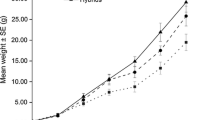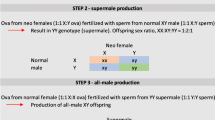Abstract
Interspecific hybridisation is common in aquaculture. The maturation of hybrids is an important issue for successive breeding and reducing the risk of genetic pollution if they escape from sea cages. This study examined the maturation of Kue-Tama, the hybrid of the longtooth grouper Epinephelus bruneus × giant grouper E. lanceolatus (LGGG) produced on 16 April 2014. We used 60 LGGG, five of which were treated with methyltestosterone (MT) and the others were not. We assessed the spermiation response (SpR) of all LGGG from March 2018 to May 2020 and sperm motility from September 2019 to May 2020. We also analysed seasonal fluctuations in plasma sex steroids (estradiol 17β [E2] and 11-ketotestosterone [11-KT]) and gonad histology from April 2018 to February 2019. We confirmed SpR in all MT-treated LGGG and in five out of 55 untreated LGGG. Some LGGG from both groups exhibited SpRs throughout the year. The spermatozoa from both groups showed vigorous motility. SpR in MT-treated LGGG occurred at low 11-KT levels (< 0.1 ng/ml), whereas that in untreated LGGG occurred at high levels (> 273.4 ng/ml). The E2 levels in a few LGGG without SpR increased significantly from September 2018 to February 2019. The April gonads were identified as ovaries without histological confirmation, whereas the July and September gonads were verified histologically. One of the three gonads collected in July 2019 contained vitellogenic oocytes. Our study demonstrated that male LGGG hybrids mature throughout the year and that females can undergo vitellogenesis in the subtropical waters and photoperiod conditions of Amami Islands.





Similar content being viewed by others
Data Availability
All relevant data supporting the findings of this study are within the manuscript, if any, and are available from the corresponding author upon reasonable request.
References
Akhoundian M, Salamat N, Savari A, Movahedinia A, Ali Salari M (2020) Influence of photoperiod and temperature manipulation on gonadal development and spawning in Caspian roach (Rutilusrutiluscaspicus): Implications for artificial propagation. Aquac Res 51:1623–1642. https://doi.org/10.1111/are.14509
Anonymous (2019) Statistics of seed production by prefecture (for aquaculture)-Pisces, Crustaceans, shellfish and the others. In: Fisheries Agency, Fisheries Research Agency, National Association for the Promotion of Productive Sea (eds) Annual statistics of seed production and release, vol 78. Fisheries Research Agency, Tokyo (in Japanese)
Arai K (2001) Genetic improvement of aquaculture finfish species by chromosome manipulation techniques in Japan. Aquaculture 197:205–228. https://doi.org/10.1016/S0044-8486(01)00588-9
Ashley PJ (2007) Fish welfare: current issues in aquaculture. Appl Anim Behav Sci 104:199–235. https://doi.org/10.1016/j.applanim.2006.09.001
Bartley DM, Rana K, Immink AJ (2001) The use of inter-specific hybrids in aquaculture and fisheries. Rev Fish Biol Fish 10:325–337. https://doi.org/10.1023/A:1016691725361
Beirão J, Boulais M, Gallego V, O’Brien JK, Peixoto S, Robeck TR, Cabrita E (2019) Sperm handling in aquatic animals for artificial reproduction. Theriogenology 133:161–178. https://doi.org/10.1016/j.theriogenology.2019.05.004
Borg B (1994) Androgens in teleost fish. Comp Biochem Physiol C 109:219–245. https://doi.org/10.1016/0742-8413(94)00063-G
Ch’ng CL, Senoo S, (2008) Egg and larval development of a new hybrid grouper, tiger grouper Epinephelus fuscoguttatus × giant grouper E. lanceolatus. Aquacult Sci 56:505–512
Chen Z-F, Tian Y-S, Wang P-F, Tang J, Liu J-C, Ma W-H, Li W-S, Wang X-M, Zhai J-M (2018) Embryonic and larval development of a hybrid between kelp grouper Epinephelusmoara ♀ ×giant grouper E. lanceolatus ♂ using cryopreserved sperm. Aquac Res 49:1407–1413. https://doi.org/10.1111/are.13591
Chevassus B (1983) Hybridization in fish. Aquaculture 33:245–262. https://doi.org/10.1016/0044-8486(83)90405-2
Chuda H, Sugano K, Nakatsukasa H, Hattori N, Kobayashi Y, Masuma S (2022) Induction of sex reversal in longtooth grouper Epinephelus bruneus by implantation of 17-alpha-methyltestosterone cholesterol pellets. Nippon Suisan Gakkaishi 88:485–493. (in Japanese with English abstract). https://doi.org/10.2331/suisan.22-00017
Dag O, Dolgun A, Konar NM (2018) onewaytests: An R package for one-way tests in independent groups designs. R J 10:175–199
Farias I, Couto E, Lagarto N, Delgado J, Canario AVM, Figueiredo I (2021) Sex steroids of black scabbardfish, Aphanopus carbo, in relation to reproductive and migratory dynamics. Aquac Fish 6:42–50. https://doi.org/10.1016/j.aaf.2020.03.006
Fennessy ST, Sadovy Y (2002) Reproductive biology of a diandric protogynous hermaphrodite, the serranid Epinephelusandersoni. Mar Freshw Res 53:147–158. https://doi.org/10.1071/MF01189
Glamuzina B, Kožul V, Tutman P, Skaramuca B (1999) Hybridization of Mediterranean groupers: Epinephelusmarginatus ♀ × E. aeneus ♂ and early development. Aquac Res 30:625–628. https://doi.org/10.1046/j.1365-2109.1999.00365.x
Heemstra PC, Randall JE (1993) Groupers of the world (family Serranidae, subfamily Epinephelinae). An Annotated and illustrated Gatalogue of the Grouper, Rockcod, Hind, Coral Grouper and Lyretail Species Known to Data. FAO Fisheries Synopsis No. 125, vol 16. FAO, Rome, pp 69–293. http://www.fao.org/3/a-t0540e.pdf
Inoue N, Iwasaki T, Shimada T, Sato J, Nishioka T (2015) Effect of salinity on the growth of juvenile longtooth grouper Epinephelus bruneus in tank culture. Nippon Suisan Gakkaishi 81:803–810. https://doi.org/10.2331/suisan.81.803. (in Japanese with English abstract)
James CM, Al-Thobaiti SA, Rasem BM, Carlos MH (1999) Potential of grouper hybrid (Epinephelus fuscoguttatus × E. polyphekadion) for aquaculture. Naga, The ICLARM Quarterly 22:19–23. http://worldfish.catalog.cgiar.org/naga/na_2187.pdf
Koh ICC, Shaleh SRM, Senoo S (2008) Egg and larval development of a new hybrid orange-spotted grouper Epinephelus coioides × tiger grouper E fuscoguttatus. Aquac Sci 56:441–451. https://doi.org/10.11233/aquaculturesci.56.441
Koh ICC, Shaleh SRM, Akazawa N, Oota Y, Senoo S (2010) Egg and larval development of a new hybrid orange-spotted grouper Epinepheluscoioides × giant grouper E. lanceolatus. Aquac Sci 58:1–10. https://doi.org/10.11233/aquaculturesci.58.1
Lee C-S, Tamaru CS, Kelley CD (1986) Technique for making chronic-release LHRH-a and 17α-methyltestosterone pellets for intramuscular implantation in fishes. Aquaculture 59:161–168. https://doi.org/10.1016/0044-8486(86)90128-6
Liao IC, Su HM, Chang EY (2001) Techniques in finfish larviculture in Taiwan. Aquaculture 200(1–2):1–31. https://doi.org/10.1016/S0044-8486(01)00692-5
Lubzens E, Young G, Bobe J, Cerdá J (2010) Oogenesis in teleosts: how fish eggs are formed. Gen Comp Endocrinol 165:367–389. https://doi.org/10.1016/j.ygcen.2009.05.022
Luin M, Fui CF, Senoo S (2013) Sexual maturation and gonad development in tiger grouper (Epinephelusfuscogattatus) × giant grouper (E. lanceolatus) hybrid. J Aquac Res Dev 5:1–5. https://doi.org/10.4172/2155-9546.1000213
Ma YM, Craig MT (2018) An inconvenient monophyly: an update on the taxonomy of the groupers (Epinephelidae). Copeia 106:443–456. https://doi.org/10.1643/0045-8511
Masuma S, Kusunoki Y, Aoki R (2021) Seasonal changes of plasma sex steroids in captive longtooth grouper Epinephelusbruneus (Bloch) in subtropical regions. Aquac Res 53:1268–1275. https://doi.org/10.1111/are.15660
Masuma S (2018) New fish for marine aquaculture by hybridization. Agricultural Biotechnology 18. Hokuryukan, Tokyo, pp 20–23 (in Japanese)
Matsuyama M, Kagawa H, Takeuchi H, Kashiwagi M, Iwai T, Hirose K (1992) Effect of LHRH-a cholesterol pellet on gonadal development, maturation and spawning in Pagrus major during winter season. Suisanzoshoku 40:159–165 (in Japanese with English abstract)
McGarvey LM, Halvorson LJ, Ilgen JE, Guy CS, McLellan JG, Webb MAH (2020) Gametogenesis and assessment of nonlethal tools to assign sex and reproductive condition in burbot. Trans Am Fish Soc 149:225–240. https://doi.org/10.1002/tafs.10226
Murata R, Kobayashi Y, Karimata H, Kishimoto K, Kimura M, Nakamura M (2014) Transient sex change in the immature Malabar grouper, Epinephelus malabaricus, androgen treatment. Biol Reprod 91:1–7. https://doi.org/10.1095/biolreprod.113.115378
Murata O, Itakura S, Yamamoto S, Hattori N, Kurata M, Ohta H, Masuma S (2017) Interspecific hybridization of longtooth grouper Epinephelus bruneus × giant grouper E. lanceolatus and growth of hybrid larvae and juveniles. Aquacult Sci 65:93–95. https://doi.org/10.11233/AQUACULTURESCI.65.93. (in Japanese with English abstract)
Mylonas CC, Zohar Y (2001) Use of GnRHa-delivery systems for the control of reproduction in fish. Rev Fish Biol Fish 10:463–491. https://doi.org/10.1023/A:1012279814708
Nagahama Y (1994) Endocrine regulation of gametogenesis in fish. Int J Dev Biol 38:217–229. https://doi.org/10.1387/IJDB.7981031
Nagasawa K, Ishida M, Octavera A, Kusano K, Kezuka F, Kitano T, Yoshiura Y, Yoshizaki G (2019) Novel method for mass producing genetically sterile fish from surrogate broodstock via spermatogonial transplantation. Biol Reprod 100:535–546. https://doi.org/10.1093/biolre/ioy204
Palma P, Takemura A, Libunao GX, Superio J, Grace de Jesus-Ayson E, Ayson F, Nocillado J, Dennis L, Chan J, Thai TQ, Ninh NH, Elizur A (2019) Reproductive development of the threatened giant grouper Epinepheluslanceolatus. Aquaculture 509:1–7. https://doi.org/10.1016/j.aquaculture.2019.05.001
Passini G, Sterzelecki FC, Avelar de Carvalho CV, Baloi MF, Naide V, Cerqueira VR (2018) 17α-methyltestosterone implants accelerate spermatogenesis in common snook, Centropomusundecimalis, during first sexual maturation. Theriogenology 106:134–140. https://doi.org/10.1016/j.theriogenology.2017.10.015
Pierre S, Gaillard S, Prévot-D’alvise N, Aubert J, Rostaing-Gapaillon O, Leung-Tack D, Grillasca J-P (2008) Grouper aquaculture: Asian success and Mediterranean trials. Aquat Conserv 18:297–308. https://doi.org/10.1002/aqc.840
R Core Team (2021) R: A language and environment for statistical computing. R Foundation for Statistical Computing, Vienna, Austria. Retrieved from URL https://www.R-project.org/. Accessed 12 Apr 2021
Sadovy Y, Liu M (2008) Functional Hermaphroditism in Teleosts Fish Fish (oxf) 9:1–43. https://doi.org/10.1111/j.1467-2979.2007.00266.x
Schulz RW, Renato de França L, Lareyre J-J, LeGac F, Chiarini-Garcia H, Nobrega RH, Miura T (2010) Spermatogenesis in fish. Gen Comp Endocrinol 165:390–411. https://doi.org/10.1016/j.ygcen.2009.02.013
Shein NL, Chuda H, Arakawa T, Mizuno K, Soyano K (2004) Ovarian development and final oocyte maturation in cultured sevenband grouper Epinephelusseptemfasciatus. Fis Sci 70:360–365. https://doi.org/10.1111/j.1444-2906.2004.00814.x
Soyano K, Sakakura Y, Hagiwara A (2008) Reproduction and larviculture of seven-band grouper, Epinephelusseptemfasciatus, in Japan. In: Liao IC, Leaño EM (eds) The Aquaculture of Groupers, 1st edn. Asian Fisheries Society, Taiwan, pp 1–27
Takano K (1989) Ovarian structure and gametogenesis. In: Takashima F, Hanyu I (eds) Monographs on Aquaculture Science Volume 4: Reproductive biology of fish and shellfish. Midori-shobo, Tokyo, pp 3–34 (in Japanese)
Viveiros ATM, Eding EH, Komen J (2001) Effects of 17α-methyltestosterone on seminal vesicle development and semen release response in the African catfish, Clariasgariepinus. Reproduction 122:817–827. https://doi.org/10.1530/rep.0.122081
Wringe BF, Jeffery WJ, Stanley RRE, Hamilton LC, Anderson EC, Fleming IA, Grant C, Dempson JB, Veinott G, Duffy SJ, Bradbury IR (2018) Extensive hybridization following a large escape of domesticated Atlantic salmon in the Northwest Atlantic. Commun Biol 1:108. https://doi.org/10.1038/s42003-018-0112-9
Acknowledgements
The authors would like to thank Mr. Hiroki Yaghi, Yoshiki Katsuda, and the staff of the Amami Station of the Aquaculture Technology and Production Center, Kindai University, who kindly assisted with the sampling. We are also grateful to Dr. Hiromi Ohta, Professor Emeritus at Kindai University, and Dr. Sho Shirakashi, Associate Professor of Kindai University, for their constructive advice. We would like to thank Editage (www.editage.jp) for English language editing. We would like to thank the anonymous reviewer and editor for their constructive inputs that helped improve the manuscript.
Funding
This study was supported by the Kindai University Fund for Domestic Research.
Author information
Authors and Affiliations
Contributions
S. M. contributed to study conception and design. S. M. and R. A. conducted the investigation and formal analyses. S. M. wrote the first draught of the manuscript and R. A. commented on it.
Corresponding author
Ethics declarations
Competing interests
The authors declare no competing interests.
Ethics approval
The study was approved by the Animal Ethics Committee of the Aquaculture Research Institute of Kindai University and was conducted according to the Guidelines for Animal Experimentation at the Aquaculture Research Institute of Kindai University.
Conflict of interest
The authors declare no competing interests.
Additional information
Handling Editor: Pierre Boudry
Publisher's Note
Springer Nature remains neutral with regard to jurisdictional claims in published maps and institutional affiliations.
Rights and permissions
Springer Nature or its licensor (e.g. a society or other partner) holds exclusive rights to this article under a publishing agreement with the author(s) or other rightsholder(s); author self-archiving of the accepted manuscript version of this article is solely governed by the terms of such publishing agreement and applicable law.
About this article
Cite this article
Masuma, S., Aoki, R. Maturation in a hybrid grouper, Kue-Tama, a cross between female longtooth grouper, Epinephelus bruneus, and male giant grouper, E. lanceolatus. Aquacult Int (2023). https://doi.org/10.1007/s10499-023-01333-y
Received:
Accepted:
Published:
DOI: https://doi.org/10.1007/s10499-023-01333-y




